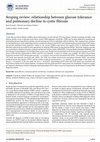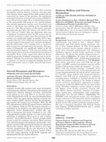Papers by Jane Holmes-Walker

Academia Medicine, Oct 25, 2024
Cystic fibrosis-related diabetes (CFRD) causes deterioration of cystic fibrosis (CF) lung disease... more Cystic fibrosis-related diabetes (CFRD) causes deterioration of cystic fibrosis (CF) lung disease, thereby increasing mortality. Lung function decline occurs at glycemic levels below current CFRD diagnostic thresholds. CFRD may be better defined by examining the relationship between lung function decline and elevated glucose levels in individuals without diabetes. This scoping review examines the existing literature on the relationship between oral glucose tolerance test (OGTT) and continuous glucose monitoring (CGM) values, and percent predicted forced expiratory volume in one second (%FEV1) and forced vital capacity (FVC) to determine whether alternative glucose levels would be more appropriate for defining CFRD based on lung function decline. Electronic database searches were performed on Medical Literature Analysis and Retrieval System Online (MEDLINE), Excerpta Medica Database (EMBASE), and the Cochrane Central Register of Controlled Trials in June 2023. Studies that assessed glucose levels from glucose tolerance test (GTT) and/or CGM and their relationship to %FEV1 and FVC were included. A total of 10 studies were included. For OGTT, three studies found that one-hour OGTT plasma glucose levels > 11.0 mmol/L were inversely associated with %FEV1. Two studies found that peak GTT levels were inversely associated with %FEV1. For CGM, four studies found inverse associations between %FEV1 and percent predicted forced vital capacity (%FVC) and the number of glucose measurements ≥ 11.0 mmol/L, the percentage of time spent with glucose > 7.8 mmol/L, or the area under the curve > 7.8 mmol/L. Intermediate OGTT values and CGM metrics are associated with lung function decline in CF without diabetes. Correlations between CGM and OGTT values need to be established. Prospective studies are required to determine whether treating elevated intermediate OGTT values can prevent lung function decline before revising CFRDdiagnostic criteria.

Diabetes Care
OBJECTIVE Continuous glucose monitoring (CGM) is increasingly used in type 1 diabetes management;... more OBJECTIVE Continuous glucose monitoring (CGM) is increasingly used in type 1 diabetes management; however, funding models vary. This study determined the uptake rate and glycemic outcomes following a change in national health policy to introduce universal subsidized CGM funding for people with type 1 diabetes aged <21 years. RESEARCH DESIGN AND METHODS Longitudinal data from 12 months before the subsidy until 24 months after were analyzed. Measures and outcomes included age, diabetes duration, HbA1c, episodes of diabetic ketoacidosis and severe hypoglycemia, insulin regimen, CGM uptake, and percentage CGM use. Two data sources were used: the Australasian Diabetes Database Network (ADDN) registry (a prospective diabetes database) and the National Diabetes Service Scheme (NDSS) registry that includes almost all individuals with type 1 diabetes nationally. RESULTS CGM uptake increased from 5% presubsidy to 79% after 2 years. After CGM introduction, the odds ratio (OR) of achieving t...
Diabetes, Obesity and Metabolism
Diabetes Research and Clinical Practice
Internal Medicine Journal

ANZ Journal of Surgery
BACKGROUND This study aimed to describe the clinical outcomes of total pancreatectomy with islet ... more BACKGROUND This study aimed to describe the clinical outcomes of total pancreatectomy with islet autotransplantation (TP-IAT) in Australia. METHODS Individuals selected for TP-IAT surgery according to the Minnesota Criteria (Appendix) without evidence of diabetes were evaluated including time to transplantation from pancreatectomy, islet numbers infused and post-transplantation HbA1c, C-peptide, total daily insulin and analgesic requirement. RESULTS Sixteen individuals underwent TP-IAT from Australia and New Zealand between 2010 and 2020. Two recipients are deceased. The median islet equivalents/kg infused was 4244 (interquartile range (IQR) 2290-7300). The median C-peptide 1 month post-TP-IAT was 384 (IQR 210-579) pmol/L and at median 29.5 (IQR 14.5-46.5) months from transplant was 395 (IQR 139-862) pmol/L. Insulin independence was achieved in eight of 15 (53.3%) surviving recipients. A higher islet equivalents transplanted was most strongly associated with the likelihood of insulin independence (P < 0.05). Of the 15 surviving recipients, 14 demonstrated substantial reduction in analgesic requirement. CONCLUSION The TP-IAT programme in Australia has been a successful new therapy for the management of individuals with chronic pancreatitis including hereditary forms refractory to medical treatment to improve pain management with 50% insulin independence rates.
Endocrinology, Diabetes & Metabolism
To determine advantages conferred by a youth‐specific transition clinic model for young adults wi... more To determine advantages conferred by a youth‐specific transition clinic model for young adults with type 1 diabetes (T1D) at Westmead Hospital (WH) as compared with Australian registry data.

Diabetes
Background: In our published trial in 120 adults with type 1 diabetes (T1D), allocation to hybrid... more Background: In our published trial in 120 adults with type 1 diabetes (T1D), allocation to hybrid closed loop (HCL) increased Continuous Glucose Monitoring (CGM) Time in Range ((TIR), 70-180mg/dL) by 15 percentage points vs. user-determined insulin dosing. Recommended TIR is >70%. Objective: To examine associations of pre-randomization factors with trial-end 3-weeks masked CGM TIR in adults with T1D treated with 6-months HCL. Methods: MDI and non-HCL pump users (no CGM) were randomized 1:1 to 26-weeks HCL (Medtronic 670G) or ongoing standard care. Analyses are on HCL group (n=55): Pre-randomization factors are related to trial-end masked CGM TIR >70 vs. ≤70% and to TIR as a continuous variable. Continuous variables are compared by t-test and binary variables by chi-square with significance at P Results: Table: Pre-randomization characteristics by trial-end TIR > vs. ≤70%. Significant univariate correlations between trial-end TIR as a continuous variable existed for pre-randomization factors: HbA1c (at enrolment and randomization), 1,5-anhydroglucitol, CGM metrics: %TIR (70-180mg/dl), %TIR (70-140mg/dl), mean glucose, SD glucose. Conclusions: The main factor associated with HCL users achieving higher TIR was pre-randomization glycemia. TIR was not associated with age, sex, prior pump use and socioeconomic status. Disclosure A. Jenkins: Advisory Panel; Self; Abbott Diabetes, Sanofi-Aventis, Other Relationship; Self; Amgen Inc., Research Support; Self; Abbott, International Diabetes Federation, JDRF, Medtronic, Mylan N. V. N. Cohen: Advisory Panel; Self; Abbott, AstraZeneca, Boehringer Ingelheim Pharmaceuticals, Inc., Lilly Diabetes, Research Support; Self; Ypsomed Group, Speaker’s Bureau; Self; Novo Nordisk. P. G. Colman: None. E. A. Davis: None. J. Holmes-walker: None. A. C. Keech: None. R. Macisaac: Advisory Panel; Self; AstraZeneca, Bayer Healthcare Pharmaceuticals Inc., Novo Nordisk, Servier Laboratories, Speaker’s Bureau; Self; Boehringer Ingelheim International GmbH, Novo Nordisk. C. M. Sims: Stock/Shareholder; Self; Medtronic. V. Sundararajan: None. S. Trawley: None. G. M. Ward: None. A. S. Januszewski: None. T. Jones: None. D. N. O’neal: Advisory Panel; Self; Abbott Diabetes, Medtronic, Sanofi, Research Support; Self; Dexcom, Inc., GlySens Incorporated, Medtronic, Pacific Diabetes Technologies. Jdrf australia adult hybrid closed loop trial: n/a. A. Kirby: None. S. A. Mcauley: Speaker’s Bureau; Self; Sanofi. M. H. Lee: None. B. Paldus: Speaker’s Bureau; Self; Medtronic. S. Vogrin: None. M. De bock: None. M. Burt: None. Funding JDRF (3-SRA-2016-351-M-B)
Medical Journal of Australia

The Journal of Clinical Endocrinology & Metabolism
Context Cardiovascular disease occurs prematurely in type 1 diabetes. The additional risk of over... more Context Cardiovascular disease occurs prematurely in type 1 diabetes. The additional risk of overweight is not well characterized. Objective The primary aim was to measure the impact of body mass index (BMI) in youth with type 1 diabetes on cardiovascular risk factors. The secondary aim was to identify other determinants of cardiovascular risk. Design Observational longitudinal study of 7061 youth with type 1 diabetes followed for median 7.3 (interquartile range [IQR] 4-11) years over 41 (IQR 29-56) visits until March 2019. Setting 15 tertiary care diabetes centers in the Australasian Diabetes Data Network. Participants were aged 2 to 25 years at baseline, with at least 2 measurements of BMI and blood pressure. Main Outcome Measure Standardized systolic and diastolic blood pressure scores and non–high-density lipoprotein (HDL) cholesterol were co-primary outcomes. Urinary albumin/creatinine ratio was the secondary outcome. Results BMI z-score related independently to standardized bl...

OBJECTIVE To investigate glycemic and psychosocial outcomes with hybrid closed loop (HCL) versus ... more OBJECTIVE To investigate glycemic and psychosocial outcomes with hybrid closed loop (HCL) versus user-determined insulin dosing with multiple daily injections (MDI) or insulin pump i.e. standard therapy for most adults with type 1 diabetes. RESEARCH DESIGN AND METHODS Adults with type 1 diabetes using MDI or insulin pump without continuous glucose monitoring (CGM) were randomized to 26-weeks HCL (Medtronic 670G) or continuation of current therapy. The primary outcome was masked-CGM time-in-range (TIR; 70–180mg/dL) during the final 3 weeks. RESULTS Participants were randomized to HCL (n=61) or control (n=59). Baseline mean (SD) age 44.2(11.7)years; HbA1c 7.4(0.9)%, 57(10)mmol/mol; 53% were women and 51% used MDI. HCL TIR increased from (baseline) 55% (13%) to (26 weeks) 70% (10%) with the control group unchanged: (baseline) 55% (12%) and (26 weeks) 55% (13%) (difference 15%; 95% CI 11, 19%; p<0.0001). For HCL, HbA1c was lower (median [95% CI] difference −0.4% [−0.6, −0.2]; −4mmol/...

Transplantation
BACKGROUND Cardiac autonomic neuropathy (CAN) is a significant cause of morbidity and mortality f... more BACKGROUND Cardiac autonomic neuropathy (CAN) is a significant cause of morbidity and mortality for people with Type 1 (T1D) and Type 2 (T2D) diabetes. Heart rate variability (HRV) has been shown to be a marker of CAN with 24-hour Holter monitoring being a robust modality to assess HRV. METHODS To investigate the impact of hypoglycaemia on CAN and its potential reversibility with islet transplantation we compared HRV assessment by 24-hour Holter monitor on a total of 109 subjects from 5 cohorts 1) T1D with recurrent severe hypoglycaemia and on waiting list for islet transplant, 2) T1D following islet cell transplantation (ICT), 3) T2D without hypoglycaemia, 4) individuals with prediabetes and 5) controls without diabetes. Standard deviation of the normal-normal interval [SDNN], Square root of the mean squared differences of successive normal-normal intervals [rMSSD] and total spectral power were analyzed. RESULTS There was no significant difference in HRV parameters between T1D subjects and T1D post ICT suggesting CAN is not reversible at a median of 4 years post islet transplant. There was a significant difference in controls and T1D in rMSSD and between controls and T2D in total power. The differential effect on rMSSD in T1D and T2D suggests potential greater impact of hypoglycaemia on rMSSD. CONCLUSIONS Achieving euglycemia after islet cell transplantation may not reverse CAN once established with no significant difference in HRV parameters at a median of 4 years post islet transplant. Differential effects of T1D as compared with T2D on CAN were identified.

Journal of the Endocrine Society
Background: Insulin resistance is an under-recognised cardiovascular risk factor in type 1 diabet... more Background: Insulin resistance is an under-recognised cardiovascular risk factor in type 1 diabetes (T1D). Individuals with T1D exhibit insulin resistance relative to those without diabetes. In T1D, tissue-specific insulin resistance (muscle, hepatic, adipose) is likely to partly drive increased cardiovascular risk. Adjunctive metformin improves muscle insulin sensitivity in T1D adolescents, but factors that predict responsiveness remain unknown.Objective: To report the rationale and design of the INTIMET study, a double-blind randomised, placebo-controlled trial of metformin in T1D.Methods: Forty adults aged 20-50 years with T1D, and 20 age- gender- and BMI- matched non-diabetic controls will be studied. T1D inclusion criteria are diagnosis > 10 years, HbA1c 9.5% and fasting C-peptide < 0.3nmol/L. Liver and muscle insulin sensitivity will be determined by the 2-stage hyperinsulinemic (20 and 60 mUm2)-euglycemic (5.5 mmol/L) clamp method with deuterated glucose. Subjects with ...

Diabetes
Background: Few long-term RCTs compare Hybrid Closed Loop (HCL) insulin delivery to manual (non-H... more Background: Few long-term RCTs compare Hybrid Closed Loop (HCL) insulin delivery to manual (non-HCL) insulin dosing in type 1 diabetes (T1D). Objective: To examine glycemic and psychosocial outcomes in adults with T1D using HCL vs. manual insulin dosing with self-monitoring of blood glucose (SMBG) for 6 months. Methods: Adults using multiple daily injections or pumps with SMBG were randomized 1:1 after insulin dose optimization to 26 weeks of HCL (Medtronic 670G) or continuation of current therapy. The primary outcome was time in target range (70-180mg/dL) with masked CGM during the final 3 weeks. Secondary outcomes included other CGM metrics, HbA1c, treatment satisfaction (DTSQs) and diabetes distress (PAID). Intention to treat analysis was performed with ANCOVA or rank sum test. Results: HCL and control groups were well balanced at baseline (Table). At 26 weeks, mean (95% CI) CGM time in range with HCL was greater by 14.8% (11.1, 18.5), with reduced high and low glucose time, and lower HbA1c. There were no between-group differences in treatment satisfaction or diabetes distress (Table). Conclusions: HCL provided a significant and sustained glycemic benefit compared with standard therapy. Results will inform potential users and health professionals and a cost-benefit analysis may facilitate HCL access. Disclosure S.A. McAuley: Advisory Panel; Self; Medtronic. Research Support; Self; Medtronic, Roche Diabetes Care. Speaker’s Bureau; Self; Lilly Diabetes, Roche Diabetes Care. M.H. Lee: Research Support; Self; Medtronic. Speaker’s Bureau; Self; AstraZeneca, Medtronic. B. Paldus: Research Support; Self; JDRF. Speaker’s Bureau; Self; Australian Diabetes Society, Medtronic. S. Vogrin: None. M.B. Abraham: Speaker’s Bureau; Self; Lilly Diabetes. L. Bach: None. M. Burt: None. N. Cohen: Advisory Panel; Self; Abbott, AstraZeneca, Boehringer Ingelheim Pharmaceuticals, Inc., Lilly Diabetes. Research Support; Self; Ypsomed AG. Speaker’s Bureau; Self; Novo Nordisk A/S. P.G. Colman: None. E.A. Davis: None. C. Hendrieckx: None. M. de Bock: None. J. Holmes-Walker: None. J. Kaye: Advisory Panel; Self; Abbott. Speaker’s Bureau; Self; AstraZeneca, Boehringer Ingelheim Pharmaceuticals, Inc., Eli Lilly and Company, Novo Nordisk Inc. K. Kumareswaran: None. R. MacIsaac: None. R.W. McCallum: None. C.M. Sims: Stock/Shareholder; Self; Medtronic. J. Speight: Research Support; Self; Abbott, AstraZeneca, Medtronic, Sanofi-Aventis. Speaker’s Bureau; Self; American Diabetes Association, Australian Diabetes Society, Roche Diabetes Care. S. Stranks: Advisory Panel; Self; AstraZeneca, Boehringer Ingelheim Pharmaceuticals, Inc., Lilly Diabetes, Sanofi-Aventis. S. Trawley: None. V. Sundararajan: None. G. Ward: None. A.C. Keech: Advisory Panel; Self; Amgen, Kowa Research Institute, Inc. Consultant; Self; Sanofi-Aventis. Speaker’s Bureau; Self; Abbott, Amgen. A. Jenkins: Advisory Panel; Self; Abbott, Medtronic. Research Support; Self; Abbott, GlySens Incorporated, Medtronic, Sanofi-Aventis. T. Jones: Other Relationship; Self; Medtronic. D.N. ONeal: None.
The Journal of Clinical Endocrinology & Metabolism
Journal of Paediatrics and Child Health
Sexual identity in congenital adrenal hyperplasia Isabelle ML Bosi , Jane Holmes-Walker, Namson S... more Sexual identity in congenital adrenal hyperplasia Isabelle ML Bosi , Jane Holmes-Walker, Namson S Lau, Slavica Bate, Gail Anderson, Michael Kohn and Simon Clarke Departments of Adolescent and Young Adult Medicine, Endocrinology, Westmead Hospital, Department of General Medicine, The Children’s Hospital at Westmead, Department of Diabetes and Endocrinology, Liverpool Hospital, Child and Adolescent Health, University of Sydney and Centre for Research into Adolescents’ Health, Western Sydney Local Health District, Sydney, New South Wales, Australia
Medical Journal of Australia

Trends in Endocrinology & Metabolism
Individuals with type 1 diabetes (T1D) frequently fail to achieve glycemic goals and have excess ... more Individuals with type 1 diabetes (T1D) frequently fail to achieve glycemic goals and have excess cardiovascular risk and premature death. Adjunctive agents may play a role in reducing morbidity, mortality, and the adverse sequelae of insulin treatment. A surge in type 2 diabetes drug development has revealed agents with benefits beyond glucose lowering, including cardiovascular risk reduction. Could these benefits translate to T1D? Specific trials for T1D demonstrate substantial hemoglobin (Hb)A1c reductions with sodium glucose cotransporter inhibitors (SGLTis) and glucagon-like peptide (GLP)1 agonists, and modest improvements with metformin, dipeptidyl peptidase-4 inhibitor (DPP4i), and pramlintide. Studies exploring cardiovascular risk reduction are warranted. This review synthesizes the emerging literature for researchers and clinicians treating people with T1D. Challenges in T1D research are discussed.





Uploads
Papers by Jane Holmes-Walker